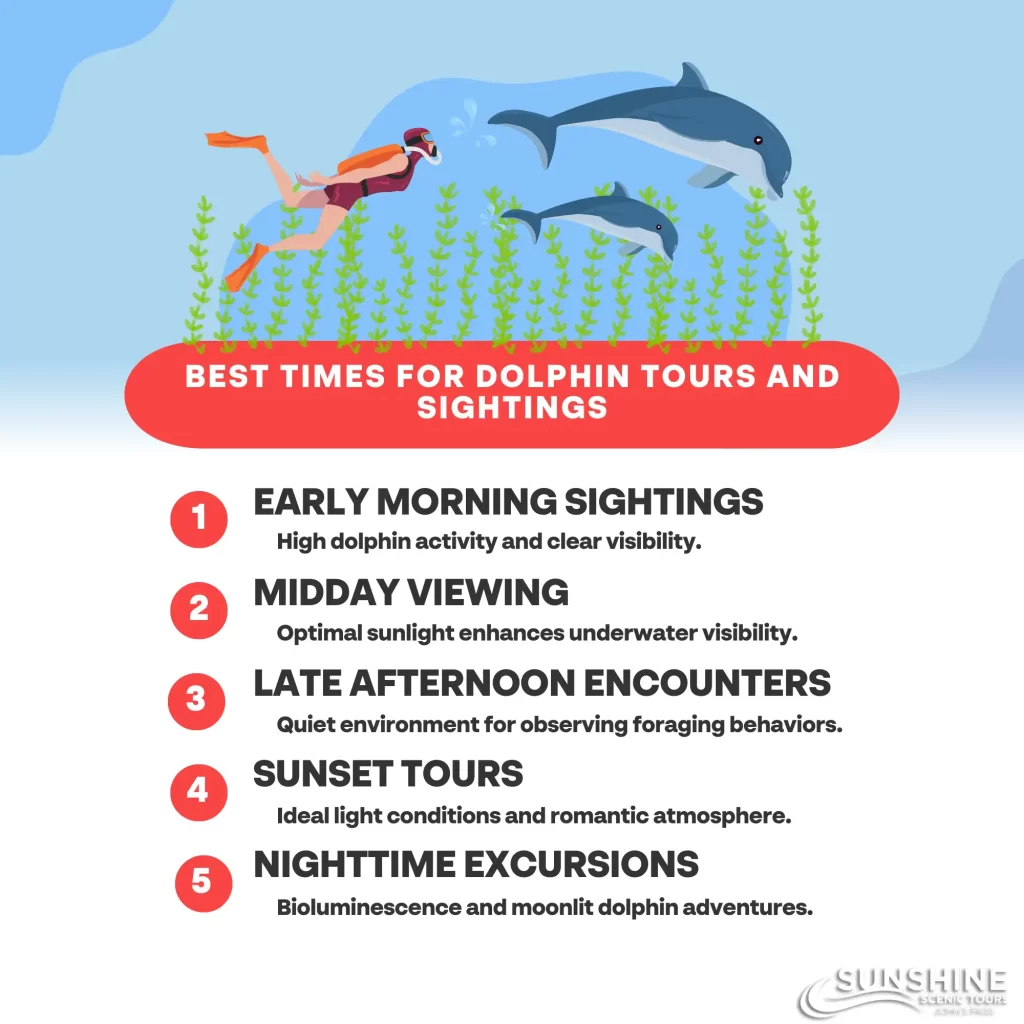When is the best time to watch dolphins? The morning is a good time to see dolphins because they are more active then. That said, dolphins are naturally more playful and active in the middle of the day, so that can also be a good time. Each animal might find food differently in the afternoon. As the day goes on, there are fewer boats and people in the late afternoon. During the “golden hour” at sunset, everything looks more romantic. This makes it even more important to see dolphins. Even tours at night can be fantastic, especially if you get to see bioluminescent dolphins swimming under the moonlight. Season and weather are also important factors. Dolphins are most active on warm, calm days. To maximize your dolphin cruise experience, remain vigilant and relish the rhythm of the sea, experiencing a sense of connection and harmony with nature.

Key Takeaways
- Early morning hours are ideal for spotting active dolphins and observing surface behaviors like breaching and tail-slapping.
- Midday offers optimal sunlight conditions, enhancing underwater visibility and making acrobatic dolphin behaviors more observable.
- Late afternoon provides a quieter environment to study dolphins’ foraging techniques and social structures.
- Sunset and golden hours enhance dolphin visibility and provide a romantic atmosphere with increased dolphin activity.
- Nighttime excursions benefit from moonlight and bioluminescence, offering a unique perspective on dolphin movements.
Early Morning Adventures
Dolphins, being diurnal animals, are often more active and easier to spot in the early morning. The period right after sunrise is particularly favorable for dolphin watching. At this time, they are more active, engaged in food-seeking and social interactions. The early morning light, with its unique quality, significantly improves visibility, thereby increasing your chances of spotting these fascinating cetaceans.
Understanding the circadian rhythms of dolphins is crucial for planning your dolphin watching trips. Like many other marine mammals, dolphins are most active in the morning. This is because they are on the hunt for food and interacting with their pod members. Notably, surface behaviors such as breaching, tail-slapping, and spy-hopping are more frequent during this time, making it the best time to observe them in action.
Late Morning Sights
During the late morning hours, dolphins often shift their behavior, engaging in more leisurely activities such as socializing and resting, which can still provide great viewing opportunities. Typically, between 9:00 AM and 11:00 AM, dolphins are less focused on feeding and more on social interactions. This period allows you to observe complex social structures, including pod dynamics and playful behaviors.
Understanding what time dolphins come out is essential for optimizing your dolphin-watching experience. Late morning sightings are particularly valuable because dolphins exhibit a range of behaviors that are otherwise less apparent during feeding times. You might witness synchronized swimming, vocalizations, and even aerial displays like breaching.
When is the best time to see dolphins if you’re interested in observing their social behaviors? The late morning hours offer a unique glimpse into dolphin life that is both relaxed and interactive. Besides, the lighting conditions during this time improve visibility, allowing you to see the dolphins more clearly. The sun’s angle reduces glare on the water, making it easier to spot these magnificent creatures. So, if you’re aiming for a well-rounded dolphin-watching experience, late morning is an excellent choice.
Midday Dolphin Viewing
During midday, you’ll benefit from ideal sunlight conditions, which improve visibility for dolphin sightings. This period also correlates with increased dolphin activity, as these marine mammals exhibit heightened social and foraging behaviors. Therefore, if you’re aiming for a thorough observational experience, midday provides significant advantages.
Optimal Sunlight Conditions
Best sunlight conditions for dolphin viewing, especially around midday, improve visibility and allow for better observation of their behaviors and interactions. When the sun is at its peak, it minimizes shadows and reflection on the water surface, improving your ability to spot dolphins. The high solar elevation angle during midday reduces the scattering of sunlight, providing a clearer view through the water column.
Additionally, the angle of sunlight at midday is nearly perpendicular to the water surface, optimizing underwater visibility. This increased light penetration facilitates the detection of dolphins’ movements and their distinctive dorsal fins. The reflective properties of dolphins’ skin also become more pronounced under direct sunlight, making them easier to identify against the backdrop of the ocean.
Moreover, polarized sunglasses can further decrease surface reflection, allowing you to see beneath the water surface more effectively. By combining these ideal sunlight conditions with the right equipment, your chances of observing dolphins engaging in social behaviors, such as bow-riding or breaching, are greatly improved. Hence, planning your dolphin tour around midday ensures that you benefit from the best possible visual conditions for an unforgettable experience.
Increased Dolphin Activity
You’ll find that midday dolphin viewing is particularly rewarding due to the increased activity levels of dolphins, often driven by their circadian rhythms and feeding patterns. Dolphins are diurnal, meaning they are active during the day. Around midday, they typically experience a surge in activity, primarily due to foraging behaviors. This period aligns with the solar zenith, enhancing underwater visibility which aids dolphins in locating prey.
During this time, dolphins engage in complex hunting strategies and social interactions. Their echolocation abilities are heightened, allowing them to efficiently detect and capture fish and squid. Midday sunlight penetrates deeper into the water, illuminating prey and creating ideal conditions for hunting.
Additionally, warmer water temperatures during midday can elevate dolphins’ metabolic rates, further stimulating their activity levels. These physiological changes are coupled with circadian-driven behaviors, making dolphins more visible and interactive.
You’ll also notice that midday is when dolphins are more likely to display acrobatic behaviors such as breaching and tail-slapping. These actions are often a part of their communication and social structure, offering a dynamic spectacle for observers. Planning your dolphin tour around midday maximizes your chances of witnessing these fascinating behaviors in their natural habitat.
Afternoon Encounters
In the afternoon, the sun’s higher position in the sky improves visibility, making it a prime time for observing dolphins’ behavior and social interactions. During this period, the increased sunlight penetrates the water column more effectively, boosting your ability to witness intricate behaviors such as pod formation and synchronized swimming. You might also notice more surface activity, as dolphins engage in breaching and tail slapping, behaviors often linked to communication and play.
Afternoon encounters provide a unique opportunity to study dolphins’ foraging techniques. With better light conditions, you can observe the sophisticated strategies these marine mammals employ to hunt fish and squid, such as cooperative hunting and the use of echolocation. Additionally, the afternoon offers a higher likelihood of witnessing mother-calf pairs, as the calm and well-lit conditions are ideal for nurturing and teaching.
The afternoon sun also aids in the identification of individual dolphins. Improved visibility allows you to discern unique markings and scars, facilitating long-term studies on population dynamics and social structure. Overall, afternoon tours maximize your observational potential, making it an excellent timeframe for both casual viewers and serious researchers interested in dolphin ethology.
Late Afternoon Watch
Why is the late afternoon an exceptional period for dolphin sightings? During this time, cetaceans exhibit increased activity due to several biological and environmental factors. Understanding these factors can greatly improve your dolphin watching experience.
- Feeding Patterns: Dolphins often engage in foraging behaviors during late afternoon as they prepare for the evening. This period aligns with the diurnal migration of prey species such as fish and squid, which ascend towards the surface, making them easier to hunt. Observing these predatory behaviors can be captivating and educational.
- Thermoregulation: As the day progresses, the water temperature can vary due to solar radiation. Dolphins, being homeothermic, regulate their body temperature efficiently. They might surface more frequently in late afternoon to thermoregulate, providing ample opportunities for sightings.
- Reduced Human Activity: By late afternoon, boating and recreational activities typically decrease, resulting in a quieter environment. Dolphins are known to be sensitive to noise pollution and disturbances. The reduced human activity can make them more visible and approachable during this time.
Sunset Tours
You’ll find that sunset tours offer unmatched opportunities for observing dolphins due to the ideal light conditions during the magical golden hours. This period improves dolphin visibility, making it easier to spot their dorsal fins and acrobatic behaviors. Additionally, the romantic atmosphere created by the setting sun provides a special and unforgettable experience for participants.
Magical Golden Hours
As the sun descends, cetaceans’ activity peaks, making sunset tours a perfect time for observing dolphins in their natural habitat. During these ‘magical golden hours,’ marine conditions often converge to create an ideal viewing experience. Dolphins exhibit crepuscular behavior, meaning they’re more active during dawn and dusk, increasing your chances of sightings.
Here are three reasons why sunset tours are excellent:
- Biorhythmic Patterns: Dolphins’ circadian rhythms align with the fading light, leading to heightened social interactions and feeding frenzies. You’ll witness their natural behaviors in a way that’s less likely during other times of the day.
- Thermocline Layer Dynamics: The setting sun affects water temperature, causing stratification. This thermocline layer attracts small fish and plankton to the surface, which in turn brings dolphins closer to the boat, enhancing your viewing opportunities.
- Reduced Human Activity: Fewer boats and watercraft are active during sunset hours, minimizing acoustic disturbances. This quieter environment allows dolphins to behave more naturally and approach boats more readily.
Enhanced Dolphin Visibility
Moreover, the enhanced visibility during sunset excursions offers a unique opportunity to observe dolphins with improved clarity, as the decreasing sunlight reduces surface glare and boosts underwater clarity. As the sun sets, the angle of incident light diminishes, which minimizes the reflective index on the water’s surface. This phenomenon allows you to peer beneath the water more effectively, enriching the likelihood of spotting dolphins in their natural habitat.
The lower light intensity at sunset also triggers changes in dolphin behavior. Dolphins often become more active during these hours, engaging in foraging and social activities. The twilight phase can stimulate planktonic organisms, subsequently attracting fish and other prey species that dolphins hunt. This increased prey availability can lead to higher dolphin activity, offering you more dynamic and engaging sightings.
Additionally, the softer lighting conditions during sunset can improve photographic outcomes. The reduced glare and enhanced contrast make it easier to capture high-quality images of dolphins. The combination of atmospheric scattering and lower solar elevation creates an ideal visual environment for both amateur and professional photographers. Thus, sunset tours not only enrich your observational experience but also provide superior conditions for documenting these marine mammals.
Romantic Atmosphere Highlights
Sunset tours offer an inherently romantic ambiance, enriched by the warm tones of twilight and the peaceful setting, providing an ideal backdrop for couples seeking an intimate and unforgettable experience. The diminishing sunlight refracts through the water, creating an engaging interplay of colors that boosts the visual appeal of the marine environment. Additionally, the diurnal behavior of dolphins often includes increased activity during the evening, optimizing the chances for sightings.
From a scientific standpoint, sunset tours benefit from:
- Reduced Photoinhibition: Lower light intensity at twilight minimizes photoinhibition, allowing better dolphin visibility as they surface.
- Behavioral Patterns: Dolphins exhibit crepuscular activity peaks, meaning they’re more dynamic during dawn and dusk, increasing interaction opportunities.
- Calmer Waters: Evening often brings reduced wind speeds, leading to calmer sea conditions that facilitate smoother navigation and better observational clarity.
Moreover, the ambient noise levels tend to drop during sunset, enriching the auditory experience. The tranquil environment, combined with the visual splendor of a setting sun, creates an almost cinematic scenario. If you’re looking to blend romance with marine exploration, sunset dolphin tours offer a scientifically enriched and emotionally fulfilling outing.
Dusk Sightings
Dusk sightings of dolphins often occur due to their crepuscular activity patterns, which means they are more active during twilight hours for feeding and social interactions. This behavior can be attributed to the reduced predation risk and best foraging conditions that twilight provides. During these hours, you’re likely to observe dolphins engaging in intricate hunting techniques such as fish-whacking, where they use their flukes to stun prey.
You’ll notice that the low light conditions at dusk make dolphins’ echolocation capabilities particularly advantageous. Echolocation allows them to navigate and hunt efficiently when visibility is limited. The twilight period also promotes social interactions within pods, as dolphins communicate using a complex array of clicks and whistles.
Water temperature and tidal movements also play an essential role. As the sun sets, thermoclines—layers of water with different temperatures—can form, concentrating fish and other prey species at specific depths. Dolphins exploit these thermoclines, making dusk an ideal time for feeding.
For ideal sightings, position yourself near areas with abundant marine biodiversity and minimal light pollution. Estuarine waters and coastal regions often provide the best vantage points. Monitoring these environmental variables will improve your chances of witnessing these remarkable marine mammals in their natural habitat during dusk hours.
Nighttime Excursions
During nighttime excursions, you’ll experience the unique phenomenon of moonlit dolphin adventures, where lunar illumination enriches the ocean’s tranquil ambiance. The reduced human activity and lower ambient noise levels contribute to a serene marine environment, amplifying the likelihood of observing natural dolphin behaviors. Additionally, the bioluminescence in some waters can make dolphins more visible, creating an extraordinary spectacle.
Moonlit Dolphin Adventures
On moonlit nights, dolphin behavior can exhibit unique patterns that differ significantly from daytime activity, offering a distinct perspective for nocturnal wildlife enthusiasts. When the lunar illumination is ideal, you might observe dolphins engaging in more social interactions, which include vocalizations and synchronized swimming. These nocturnal behaviors are influenced by celestial light, which can impact their foraging activities and predator avoidance strategies.
Here are three aspects to keep in mind for your moonlit dolphin adventure:
- Amplified Bioluminescence: The gentle glow of the moon can amplify the visibility of bioluminescent organisms in the water. Dolphins swimming through these glowing waters create a captivating light show, which is biologically fascinating and visually striking.
- Modified Feeding Patterns: Dolphins might adjust their feeding strategies based on the availability of prey that is influenced by the lunar cycle. Night tours can provide insights into these adaptive behaviors, offering a rare glimpse into their ecological dynamics.
- Nighttime Communication: Dolphins’ echolocation and communication methods can become more pronounced at night. The quieter environment allows for the detailed study of their sonar clicks and whistles, which are essential for navigation and social interaction.
Understanding these nocturnal behaviors enriches your appreciation of dolphin ecology and elevates the overall experience.
Quiet Ocean Serenity
How can the tranquil atmosphere of nighttime ocean excursions improve your understanding of marine life behaviors and ecosystems? By venturing out during these serene hours, you’re exposed to a less disturbed marine environment. The absence of daytime human activity reduces noise pollution, allowing you to observe more natural behaviors. Dolphins, for example, may exhibit nocturnal feeding patterns, utilizing echolocation more prominently in the quiet waters, which you can detect using hydrophones.
The reduced light pollution also means you can observe bioluminescent organisms, such as phytoplankton, creating a surreal glow in the water. This phenomenon can provide insights into the distribution of these microorganisms and their role in the marine food web. Additionally, the calm sea state at night often results in clearer water, making it easier to study underwater visibility and its effects on marine species’ communication and hunting strategies.
Enhanced Dolphin Visibility
Nighttime excursions significantly enhance dolphin visibility due to diminished surface glare and lower levels of ambient light interference. When the sun sets, the water’s surface becomes less reflective, enabling you to see dolphins more clearly as they break the surface. This reduced glare is essential for spotting dolphins’ dorsal fins and the smooth, continuous movement patterns typical of their swimming behavior.
Furthermore, lower ambient light levels mean fewer distractions, making it simpler to focus on the dolphins’ natural luminescence. Dolphins can sometimes emit bioluminescence, a natural glow created by microorganisms on their skin. This phenomenon is simpler to observe in the dark, providing a distinctive and captivating experience.
Consider these key benefits of nighttime excursions:
- Diminished Glare: With less sunlight, the water’s surface is less reflective, making dolphins easier to spot.
- Improved Focus: Lower ambient light means fewer visual distractions, allowing you to concentrate on observing dolphins.
- Bioluminescence Visibility: Nighttime conditions make it easier to see the natural glow produced by microorganisms on dolphins’ skin.
Seasonal Variations
Seasonal variations strongly influence dolphin sightings, with peak activity often observed during specific times of the year due to changes in water temperature, prey availability, and breeding cycles. During warmer months, typically spring and summer, water temperatures rise, which can boost the metabolic rates of dolphins, leading to increased activity levels. This period is also characterized by abundant prey such as fish and squid, which are crucial for dolphin sustenance.
Breeding cycles also play a vital role in seasonal variations. Many dolphin species have calving seasons that coincide with warmer waters, as these conditions provide an excellent environment for the survival of newborn calves. You’ll often witness more social behaviors, such as pod formations and cooperative hunting, during these times.
In contrast, cooler months can result in decreased sightings. Dolphins might migrate to warmer waters or deeper oceanic areas where temperatures are more stable. The availability of prey also diminishes during these periods, prompting dolphins to spread out over larger areas in search of food. Consequently, your chances of spotting dolphins can be notably lower during the fall and winter seasons. Understanding these seasonal patterns can greatly enrich your dolphin tour experience.
Weather Impact
Weather conditions greatly influence dolphin sightings, as factors such as wind speed, wave height, and precipitation can alter dolphin behavior and visibility. When planning your dolphin tour, it’s essential to take into account the meteorological elements that can maximize your chances of a successful sighting.
- Wind Speed: High wind speeds can create choppy waters, reducing visibility and making it harder for dolphins to surface. Calm days with low wind speeds are ideal, as the smooth water surface allows you to spot dolphins more easily.
- Wave Height: Significant wave heights can obscure dolphins from view and disrupt their typical behavior patterns. Smaller waves are more favorable for sightings since dolphins prefer calmer waters for activities like feeding and socializing.
- Precipitation: Heavy rainfall can decrease water visibility and deter dolphins from surfacing frequently. Light rain might not have a significant impact, but clear, sunny days are usually the best for sightings. Dolphins are more likely to be active and visible under these conditions.
Conclusion
To sum up, the best times for dolphin tours range from early morning to nighttime, each offering unique viewing experiences. Peculiarly, research shows that dolphins are most active during the early morning, with activity levels peaking at around 6 AM—imagine a pod of dolphins leaping against a sunrise backdrop. Seasonal and weather variations further influence sightings, emphasizing the importance of timing. By understanding these patterns, you can maximize your chances of an unforgettable dolphin encounter.when are dolphins most active











